WattCycle LiFePO4, value battery with a punch

You may not have heard of WattCycle before, but if you are in the market for a value oriented lithium iron phosphate battery, you should probably take note. WattCycle offers numerous batteries in multiple voltages at attractive price points. We have certainly seen batteries with low price tags and performance to match. So, the question is, how will WattCycle’s batteries perform? I have tested a pair of batteries extensively and have some pretty positive results to share.
I tested a pair of WattCycle’s 12 volt nominal, 100 amp-hour lithium iron phosphate (LiFePO4 or LFP) batteries with low temperature cutoff and Bluetooth communications. The batteries roughly fit BCI’s Group 24 size and currently sell for $219.00. WattCycle offers a possibly excessive number of 100 amp-hour, 12 volt batteries. Five to be exact. They offer a mini battery with and without Bluetooth communications (both are $189), a group 24 with and without communications, and a “pro” battery without communications and a lower rated BMS than the Bluetooth group 24. I can’t see why you would buy a battery without Bluetooth communications when one is offered at the same price with them.
WattCycle’s 12 volt batteries are available in sizes up to 300 amp hours or 3,840 watt hours. They also offer a 24 volt, 100 amp-hour battery that delivers 2,560 watt hours. For higher voltage configurations, they offer bundles of two, three, and four batteries. The 12 volt batteries support up to 4 parallel and 4 series installations. The 24 volt batteries also support 4 parallel but limit series length to 2 batteries.
Battery construction
The case of the 100 amp-hour, group 24 battery I am evaluating is glued together. As a result, dissassembly requires some creative prying and pounding. Fortunately, the case wasn’t too hard to get apart and I was in pretty quickly. The 100 amp hour mini battery’s case is screwed together which makes disassembly a lot easier.

Once inside the battery I found a no frills but nicely constructed battery. The BMS sits well secured atop the cells. It is nice to see no foam in the case with everything instead secured via a well fit cell holder system. I wasn’t able to find a size marking on the positive conductor, but I think it is likely a 4 AWG wire. The negative leads both to the BMS and from the BMS to the negative stud are dual 8 AWG wires.
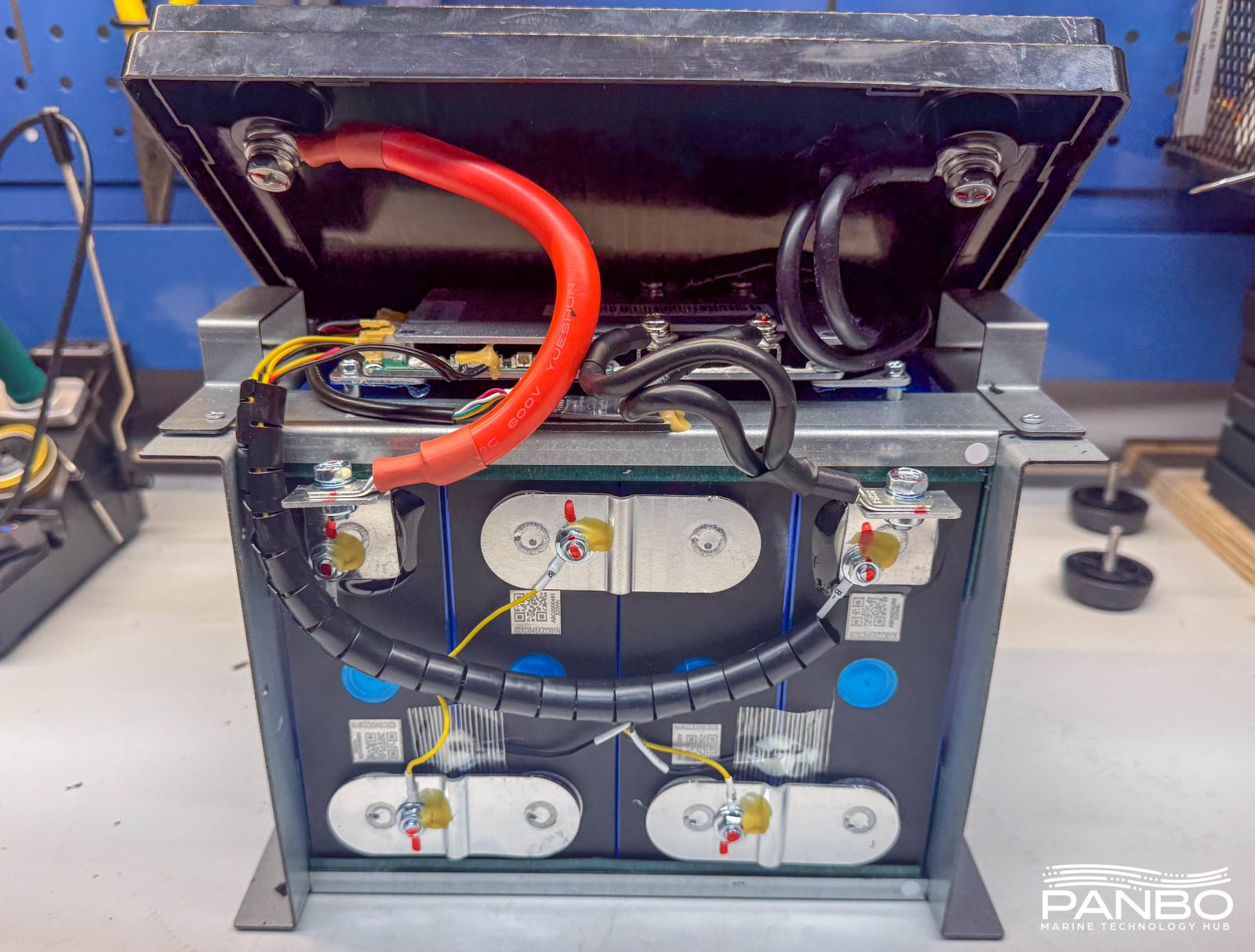
Once I removed the cell pack from the case, I found the cells are actually on their side. A relatively stiff and robust metal frame holds the cells in place. There are two temperature sensors on the cells. Spot welds secure the bus bars to the cell terminals as well as the positive and negative connections from each end of the pack. Lastly, the balance and temperature sensor wiring is protected in a spiral loom.
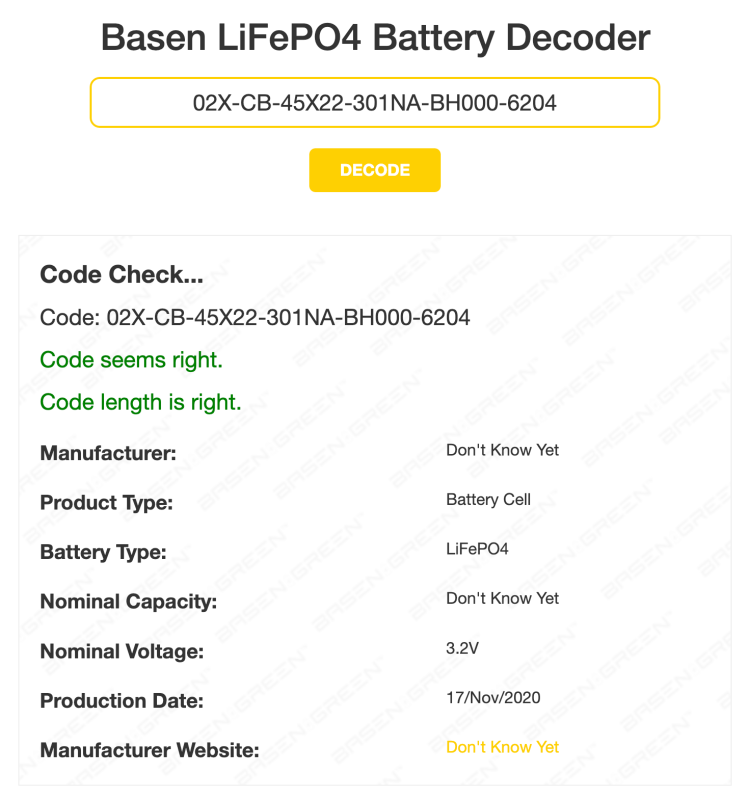
Interestingly, the QR codes for these cells don’t decode using any of the decoders I usually use. I am not sure if WattCycle is getting their cells from a new manufacturer or if the QR codes have been modified or faked in some way. I don’t really suspect that to be the case based on everything I’m seeing, but anything is possible.
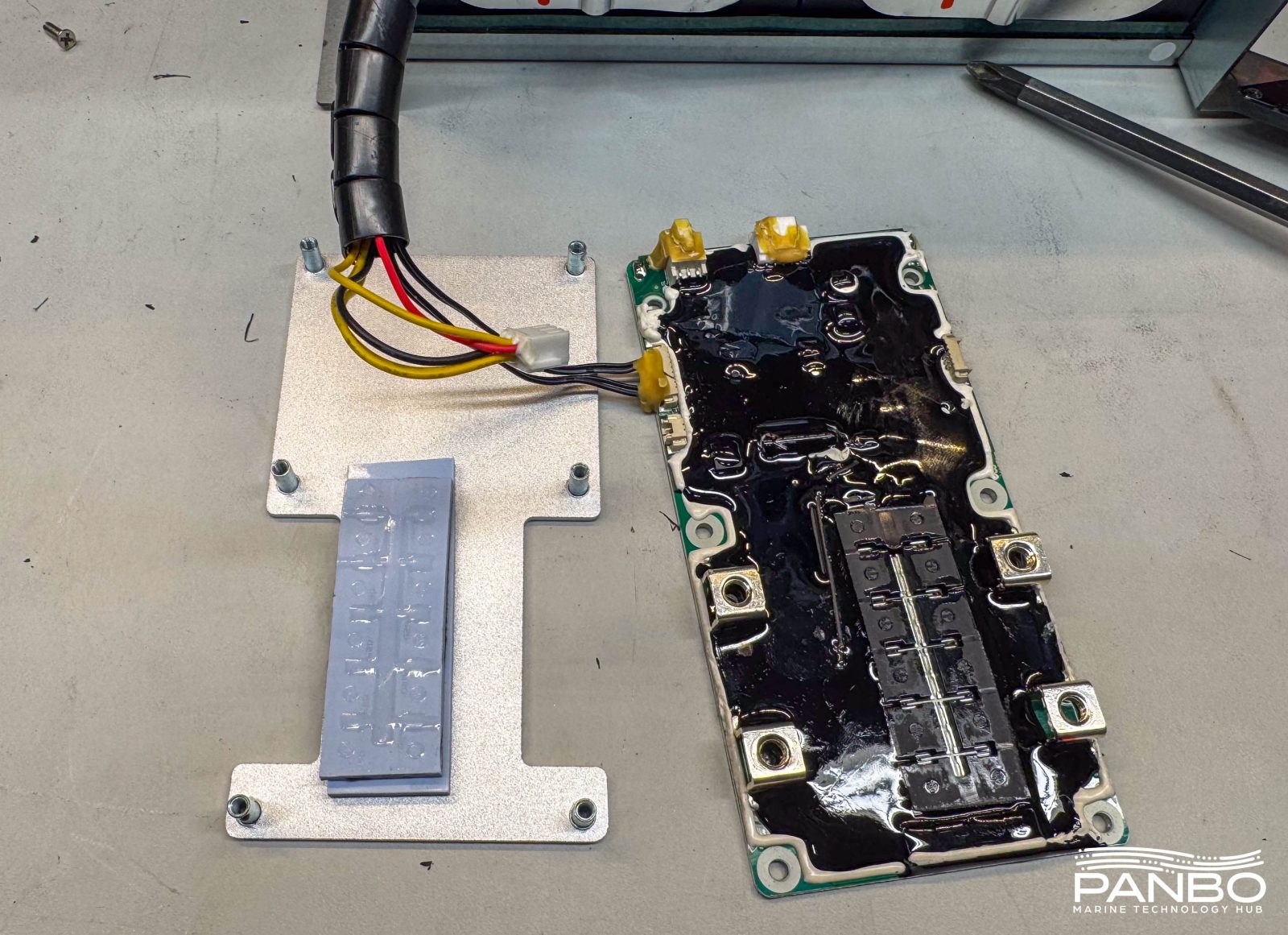
As soon as I removed the heat sink from the BMS, I knew I wasn’t going to learn too much about it. Black epoxy coats the entire circuit board. That certainly cuts down on any conclusions about the BMS beyond the 12 FETs visible at the bottom of the board. I assume these FETs are divided into charge and discharge banks meaning there are six for each purpose. Physically, this BMS is a good bit smaller than most I’ve reviewed recently. But, the proof will be in the pudding of how the battery performs and we will get to that next.
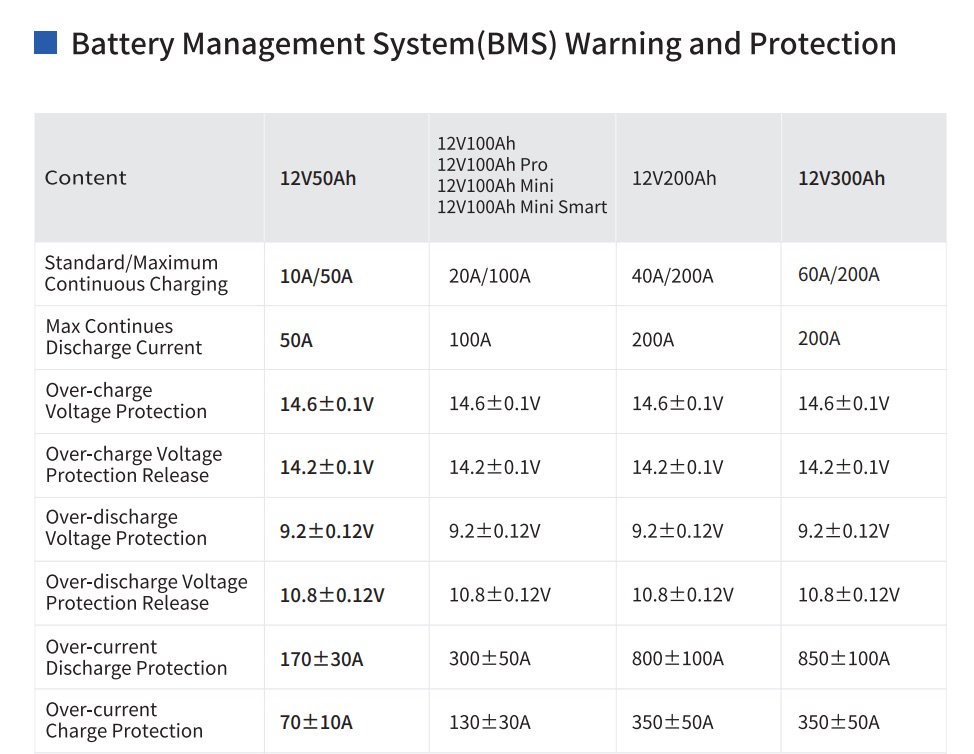
No review of a battery is complete without taking a look at the manual itself. WattCycle’s manual is better than most value oriented brands. The manual includes good detail on the operating parameters of the battery, installation instructions, wiring diagrams, and more. Unfortunately, there is some detail specified in ABYC’s E-13 Lithium standard lacking from the manual. That lack of detail, including items like physical restraint, would make it difficult to complete a compliant install with these batteries.
Battery performance
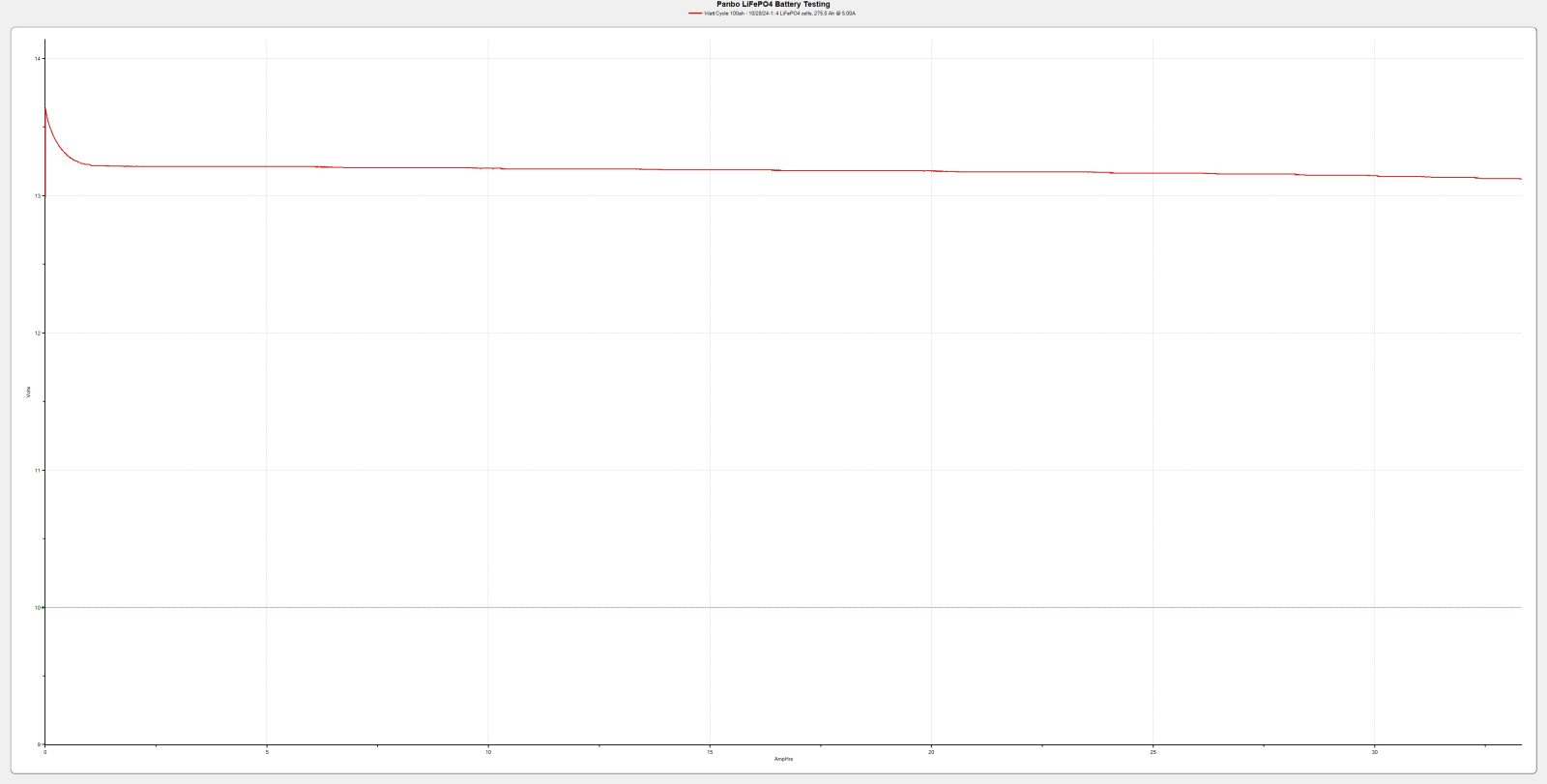
First up, a capacity test of the battery confirms it delivers in excess of its 100 amp-hour rated capacity. In this case, it was just a little bit over at about 101.75 amp hours. That is slightly under the 2-3 percent margin over rated capacity I typically see, but still exceeds the manufacturer’s claim. That’s a luxury to which we are becoming accustomed.
If you watch the video section above on high throughput testing, you will hear I had some skepticism about the battery’s ability to sustain their 120 amp rating. The reality was, the battery greatly outperformed that rating and only shut down at almost 200 amps of energy coming out of it. For a 100 amp-hour battery, that is crazy (and a little concerning). At that rate, the battery will deplete its energy in half an hour. Although the performance does meet WattCyle’s 220 amp current protection spec, I feel this might be a little too high for a 100 amp hour battery. Overall, the battery met or exceeded WattCycle’s ratings and performed far better than I expected for a $219 battery.
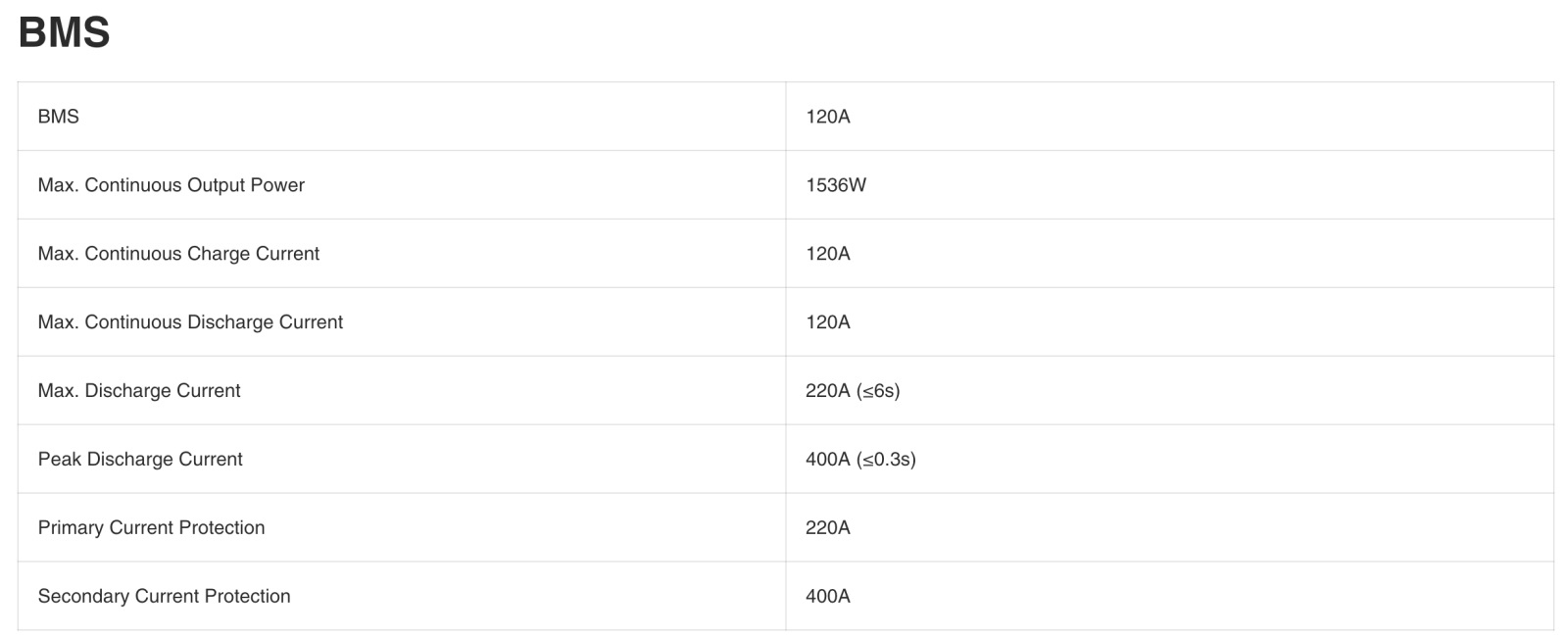
It might sound irrelevant that a 100 amp hour battery can deliver huge current without shutting down. But, take a look at the data table above. The BMS handles surge currents of 220 amps for up to six seconds and 400 amps for 0.3 seconds. Those huge peak current ratings help with inrush current from large motor loads including windlasses, thrusters, and possibly even engine starting (although WattCycle’s manual says the batteries are not to be used for starting). The ratings are impressive for a single battery, but I would expect that generally, boaters will build banks of 2-4 batteries in parallel. As a result, the current handling numbers are multiplied by the total number of batteries in parallel.
The app
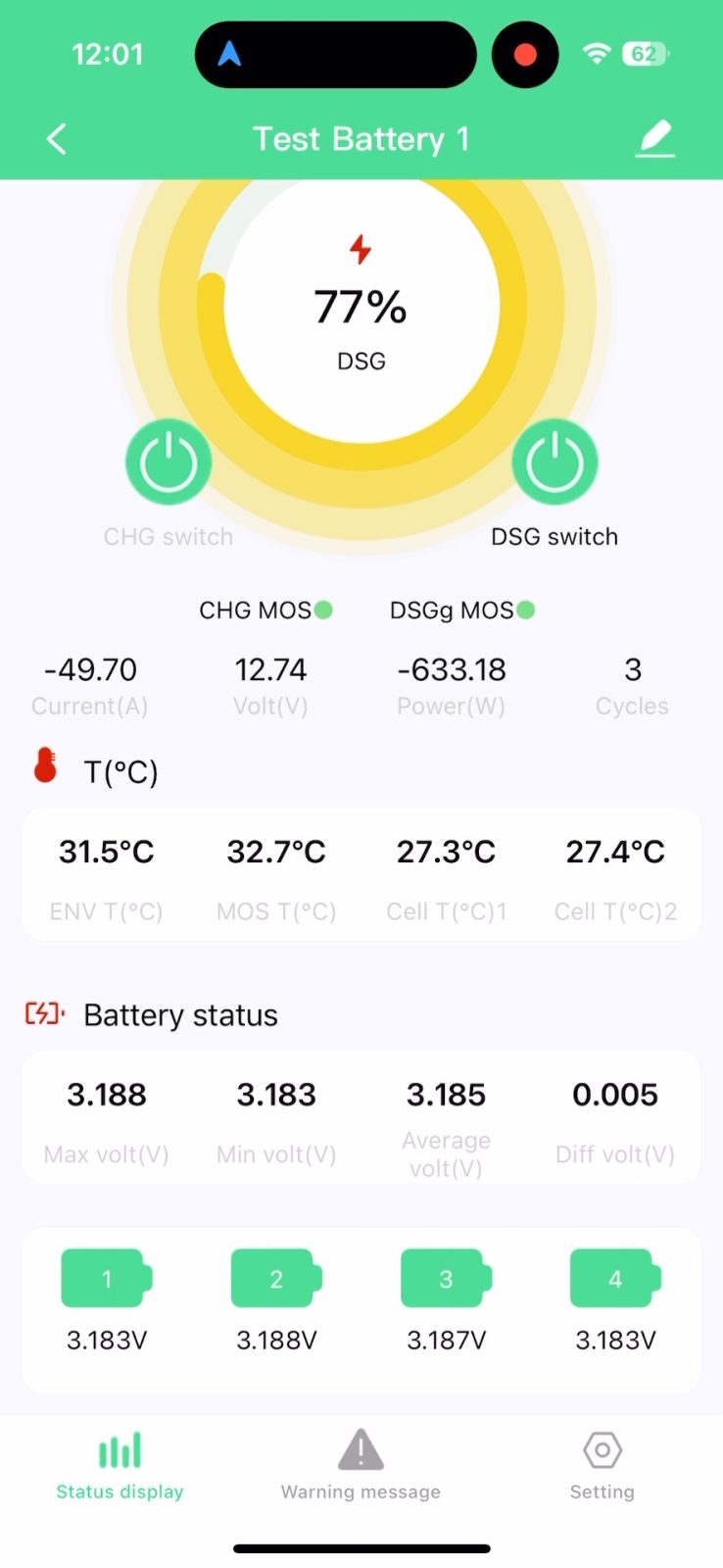
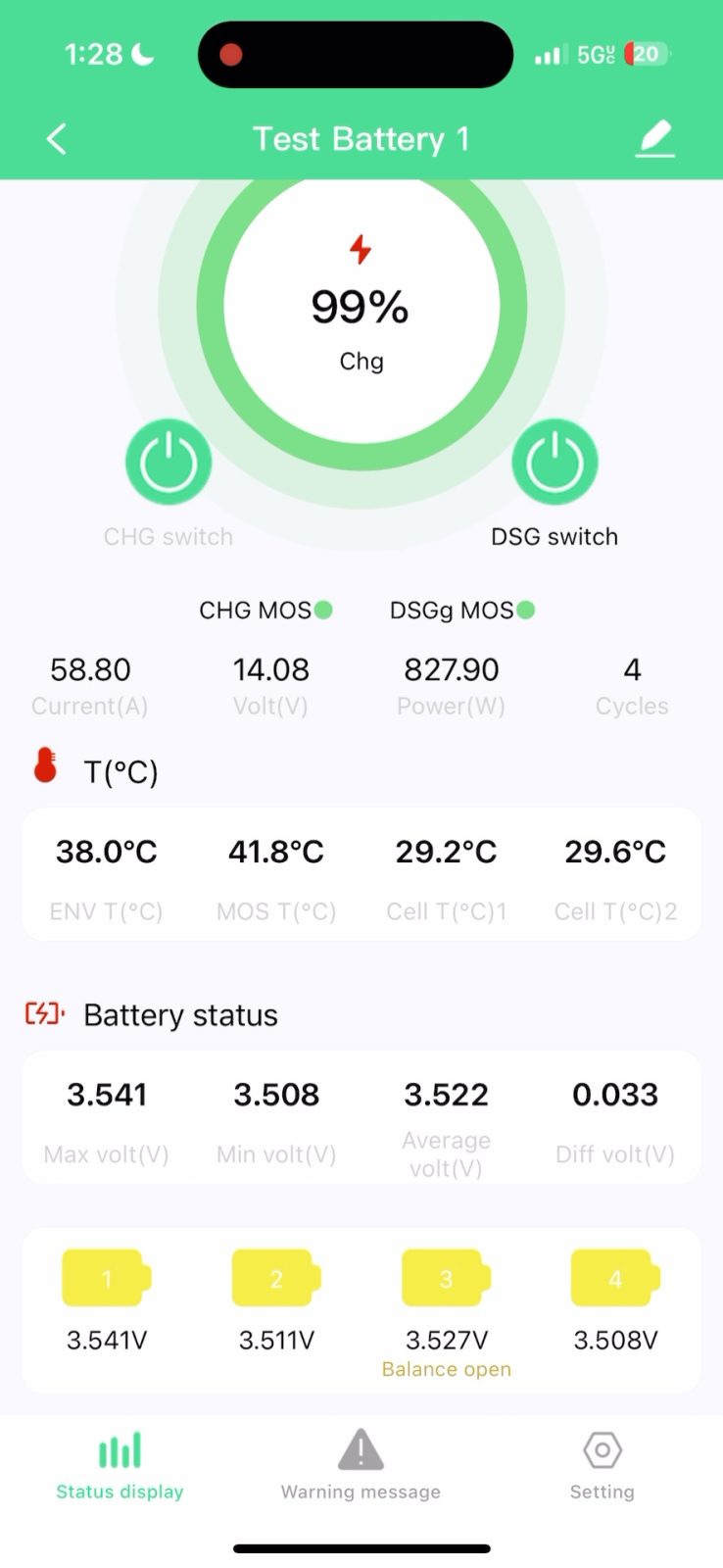
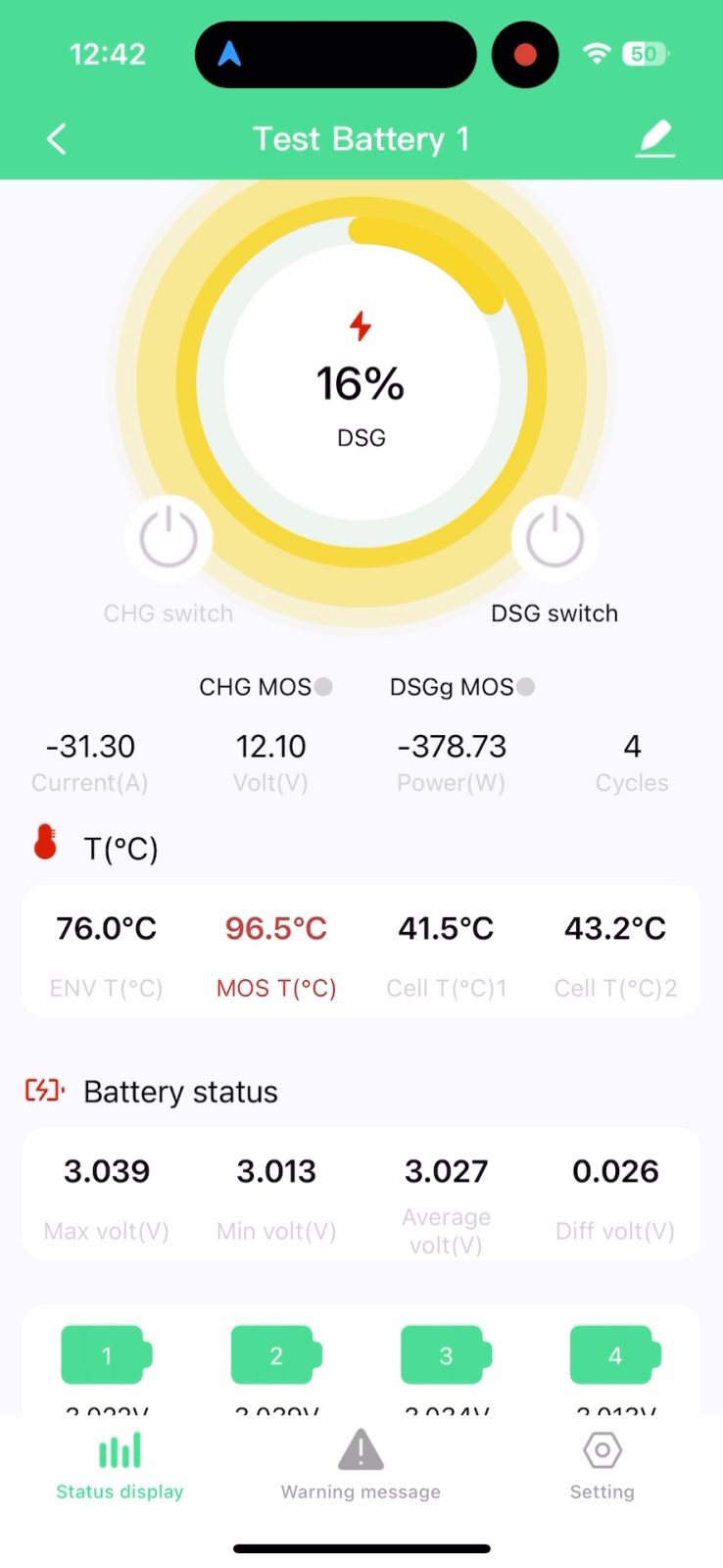
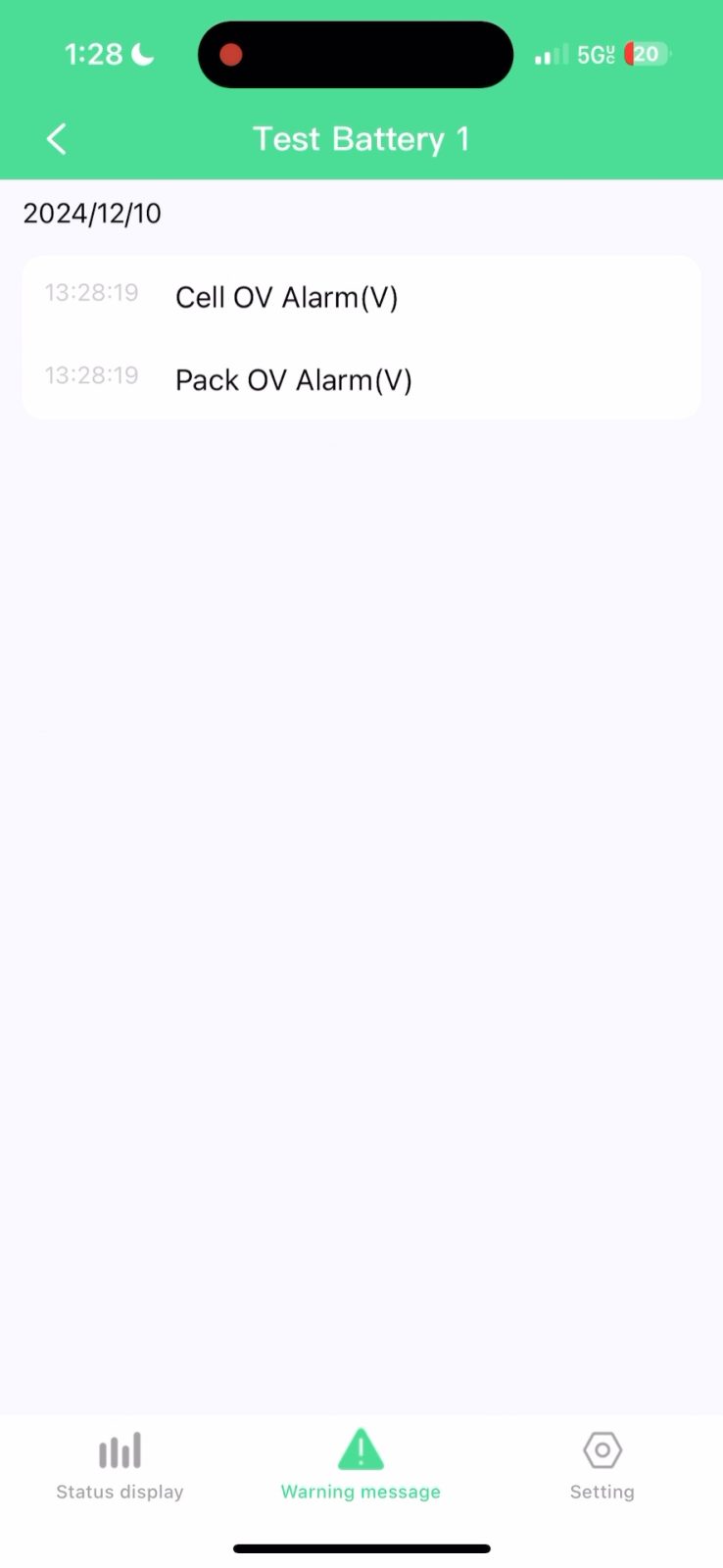
The app used for the batteries, named BMS Meta, isn’t WattCycle branded. Presumably the BMS manufacturer also publishes the app. The app provides good monitoring of the battery’s status and clearly shows any issues the batteries may be experiencing. The only oddity I observed, and I don’t know if it is an app issue or a BMS issue, involved cell balancing. Any time the BMS initiated balancing, the words “Balance open” appeared under the third cell. The second screenshot above shows this issue. The third cell always shows balancing, even if it is not the highest voltage cell. I suspect balancing is working as it should and there’s a bug in the way it is displayed.

WattCycle publishes a surprisingly thorough and readable manual for the Bluetooth app. The manual includes good diagrams showing the meaning of various information presented in the app. Often I question the value of the data in the app if the user doesn’t understand what’s presented. The manual certainly helps increase the usefulness of the information.
Charging the battery
Like quite a few other recent batteries, WattCycle manages charging the battery by disconnecting the charge MOSFETs when the battery is full. These disconnects protect the cells from overcharging. LiFePO4 cells can be damaged by prolonged high voltage,low amperage charging. Since LiFePO4 battery manufacturers offer long warranties, they want a way to protect themselves from having to warranty failed batteries attributable to mistreatment. The solution they’ve found is to disconnect the charge MOSFETs.
I first ran across this behavior with the Epoch 460 amp hour marine battery. I didn’t like it with that battery and I don’t like it any better with this one. In fact, the behavior on these batteries seems a little worse. The Epoch 460s enter full current protection when the pack voltage exceeds 14 volts and charge current acceptance drops below 3.5 amps for 10 seconds. WattCycle seems not to use current acceptance, instead disconnecting as soon as the pack reaches 14.2 volts. In my testing, I saw disconnects occur with 25 or more amps of charge going into the battery.
Charge sources expect the battery they are supplying energy to stay connected. If the charge is coming from an inverter, the sudden disconnection of the batteries will lead to voltage spikes. If the charge source is an alternator, the sudden disconnect will also lead to a voltage spike, but the alternator is also vulnerable to significant damage.
When we design DC power systems on boats, we make some basic assumptions. One of those assumptions is that batteries will stay connected. With LiFePO4 batteries we understand that the batteries may disconnect in the event of a significant safety issue like a short circuit, over current situation, or over temperature. However, in my mind, a battery disconnect occurring when the battery and surrounding DC system are operating normally is undesirable.
You are likely to read a rant similar to this in every review I do of batteries with this functionality. Fortunately, the workaround isn’t terrible. In order to avoid this behavior, we can reduce the absorption voltage. For the WattCycle battery, I was able to set absorption to both 13.9 and 14 volts without any undesirable disconnects. Although this reduced voltage might slightly increase charge time, I don’t expect that increase will be significant. Additionally, as I determined in another test, the total energy capacity of the battery is likely to remain unchanged with a small decrease in absorption voltage.
Final thoughts
$219 for a 100 amp-hour battery with Bluetooth, good construction and capable of deliver double its capacity is a serious bargain. I wish the charge disconnect behavior was different, but I may just have to make my peace with that. With available capacities up to 300 amp-hours at 12 volts, a large house bank can be constructed. I am confident these batteries can be used to build a reliable house bank at a serious value. It will be interesting to see what batteries they offer in the future and if feedback from reviewers like me, and potentially customers like you, can change the tide on full charge disconnects.
Editor’s Note: Panbo doesn’t participate in the affiliate link programs battery manufacturers use. Those link programs are a big part of the reason you see so many YouTube videos proclaiming each battery as the best. I am not comfortable making money from a product I review. But, my friend Rodd Collins over at MarineHowTo.com is a WattCycle affiliate. As you may know, Rodd’s contributions to the marine electrical world are hard to quantify and value, but suffice it to say they are extensive. Rodd had a stroke a few years ago and is not able to work as a marine electrician or run his online shop. So, if you’re going to buy a WattCycle battery anyways, please use Rodd’s affiliate link: https://www.wattcycle.com/?ref=MHT and coupon code MHT8. You will save 8% and Rodd will make a few dollars as well.


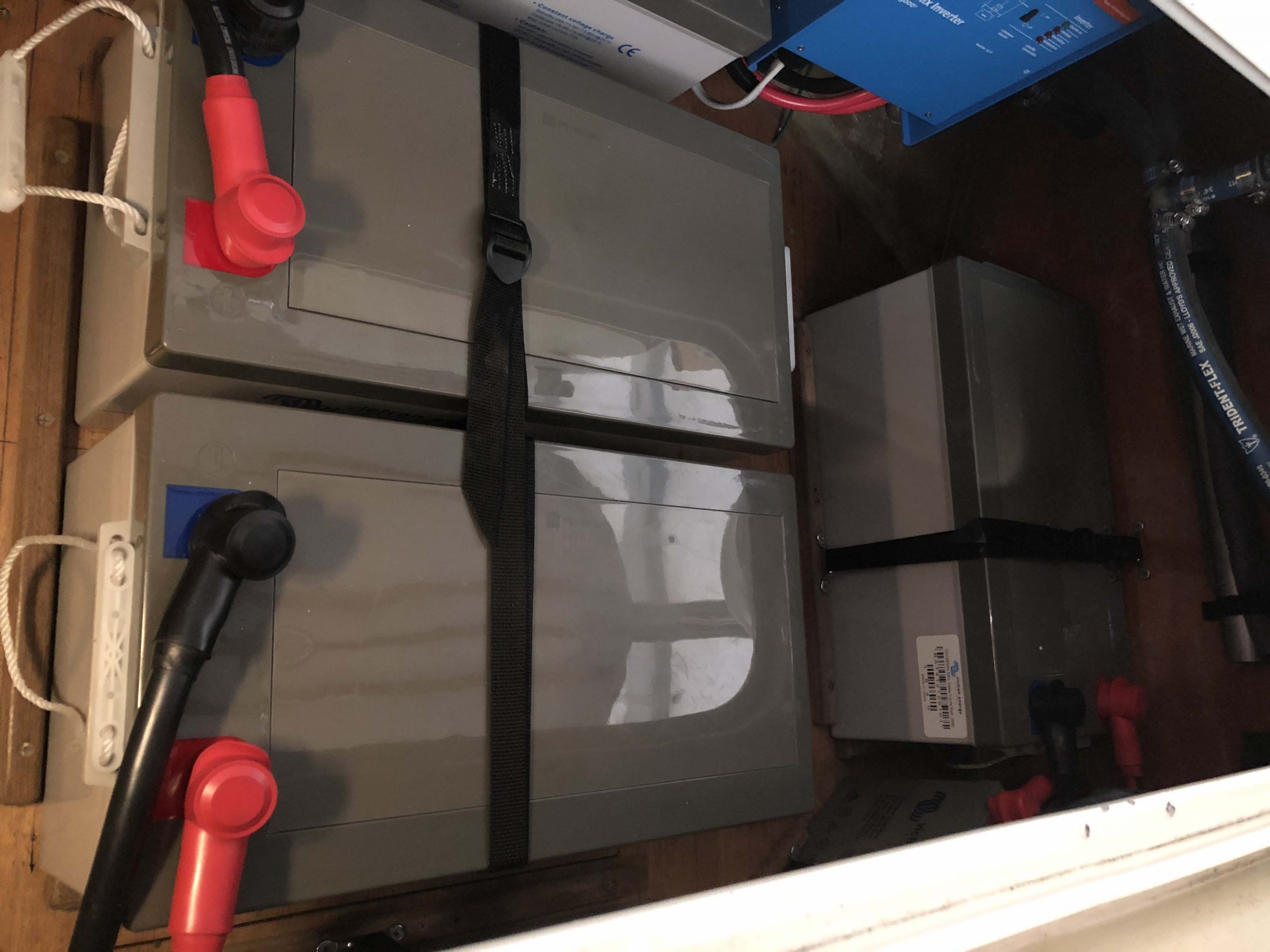
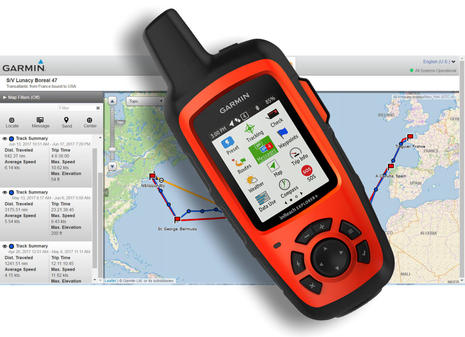
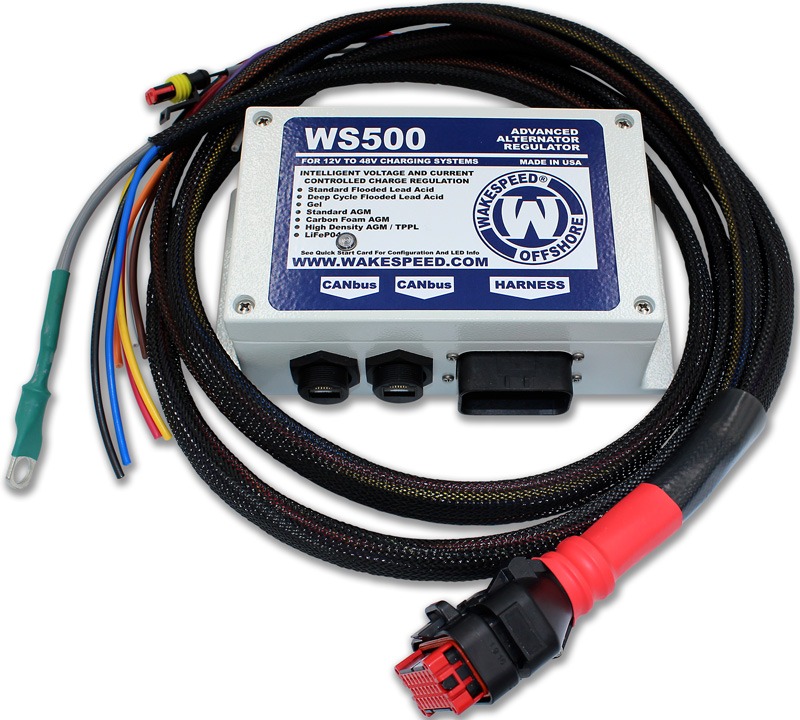








Will Prowse on YouTube recently did a review on the Watt Cycle 300 and found two interesting things:
1) The cells are actually 280Ah cells, not 300Ah cells. WattCycle (doing damage control since Will has almost 1M subscribers) owned up to it and promised to re-label future batteries, gave $50 refunds to prior purchasers, and is offering a discount (though still more than Black Friday when the batteries were incorrectly advertised as 300Ah) on future purchases.
2) The BMS current limit allows the 300/280Ah battery to put out a sustained 850A and the parts inside the unit are not rated for that amount of current. WattCycle said that they are going to address this in future versions. As such, don’t count on the BMS to protect against over current and make sure to have a suitable fuse on a terminal of this battery. Will also did a review on another 280Ah battery from Eco Worthy (that uses a different BMS) and found the same problem.
Good article.
I am looking to replace my 90Ah lead-acid battery with one like this LiFePO4 and have questions about charging from a solar panel.
I use a 30W or so panel to keep the lead-acid battery charged. Since it has no BMS, I have a cheap regulator on the panel. It seems to work ok, with typically 13.8V showing on the battery after a long time in the sun.
Questions:
Will the LiFePO4 battery BMS and the regulator on the panel work well together? I imagine having essentially two regulators in the system could lead to a problem.
Also, I don’t think the panel regulator is adjustable. If it were, how would I set it?
The panel regulator instructions say to always connect the battery before connecting the panel, i.e., the regulator should not see an open circuit on its output. I assume this is to prevent overvoltage which may damage the regulator. The article about the WattCycle battery says that its BMS disconnects the charging source when the battery is fully charged. How do I prevent damage to the regulator?
Could I use the solar panel directly with no regulator? I think this may work since the BMS will prevent overcharging and the panel itself should tolerate an open circuit.
Comments, questions and more information are appreciated.
Thanks,
Noel
I put several of these Watt Cycle 100Ahr minis in my sailboat. I am thankful that your load testing showed full capacity because the BMS charge indication tends to be much more optimistic that my Balmar battery monitor.
I did have something of concern happen recently. After leaving my wind generator on during a period of high winds, three of my batteries had a cell overvoltage fault and disconnected themselves. The problems was that we were in a remote anchorage and needed to get out of there with some weather coming…
The issue I saw was the spread between the cell overvoltage disconnect and reconnect voltages because once the battery disconnects, the only way to get a cell voltage down is the passive balancing which is slooow. Luckily I found the BMS password online (88888) and was able to look at some of the protection settings. The factory settings for cell overvoltage disconnect/ reconnect are 3.65/3.350, but dissipating 0.3v can be a looong wait. Interesting Victron’s settings are 3.65/3.5 which seems more reasonable. Many of the Victron settings look better to my eyes.
Another issue that readers may want to know about is the app’s seeming ability to shut down the charging or discharging independently. While one can shut down the discharge side and still charge, turning off only the charging selection takes the battery completely offline as can be seen by the discharge amperage going to zero.
I would suspect that most of the budget lithium batteries have hidden issues, so my intent is not to bash Wattcycle but to let others know of their possible limitations.